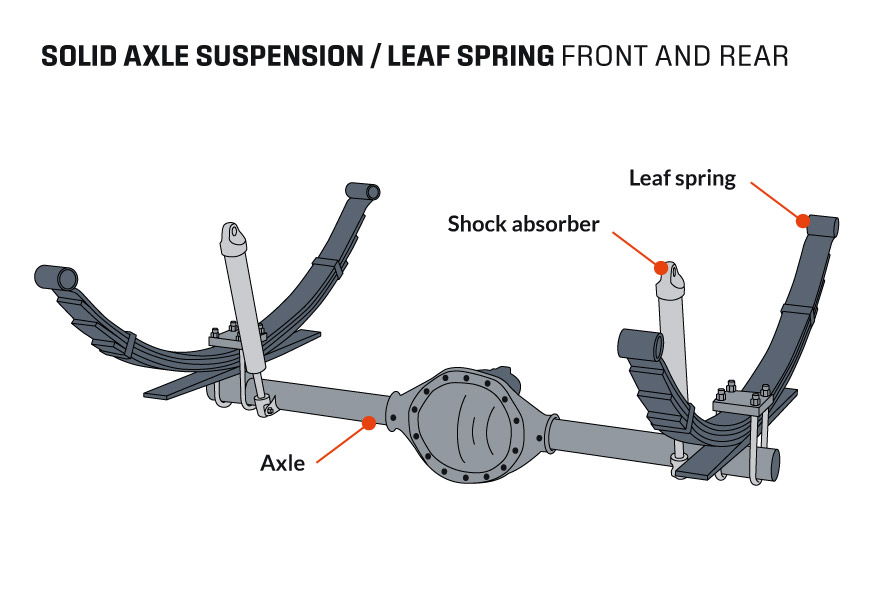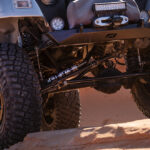
How to lift a pickup truck? Suspension lift on leaf springs
In modern vehicles, leaf springs are becoming rare. Still, they remain an integral part of the suspension system in many classic off-road vehicles, especially pickup trucks. The most famous example of a car that still uses leaf springs is the immortal Corvette. Popular models like the Ford Ranger, Toyota Hilux, Nissan Navara, Volkswagen Amarok, Ford F150, Isuzu D-Max, Toyota Tundra, and Toyota Tacoma still rely on leaf springs. So, what role do leaf springs play in pickups, and how can you enhance a typical work vehicle for better off-road performance? Here’s how to lift a leaf spring suspension.
Using leaf springs: Why are they in off-road vehicles?
Before we tell you how to lift a pickup, here’s a short introduction. Leaf springs consist of several large, curved metal plates known as leaves, joined together with clamps or clamps and center bolts. They are attached to the frame or body with joints in the form of bushings with a pin at the front and a shackle at the back.
In many 4×4 vehicles, leaf springs are mounted parallel to the axles, supporting two distant points on the chassis. This design helps distribute weight more effectively, particularly in the cargo area. Leaf springs are mounted to the axle using U-bolts. The size of the U-bolts varies depending on the type of axle. Such as Dana 44, Dana 35, or Chrysler 8.25, and the size of the axle housing.
Leaf springs enhance the stability of the suspension system and improve the vehicle’s ability to carry vertical loads. This makes them ideal for heavy vehicles, especially on the rear axle. This is why leaf springs are still commonly used in off-road vehicles, particularly in pickups with dependent rear suspension, where they can increase the vehicle’s load capacity to over 1000 kg (approximately 2200 lbs).

Leaf springs and shock absorbers: How they work
Leaf springs can transfer forces in three directions and absorb energy during acceleration and braking. Their primary function is to support the vehicle’s weight and provide cushioning (springing) effect, but they also guide the wheels and can replace control arms. Additionally, leaf springs offer some damping, though this is not their main purpose; it’s a byproduct of their multi-layered construction.
When the suspension flexes, friction between the individual leaves absorbs some of the shocks transmitted through the wheels. This frictional damping can reduce riding comfort, especially off-road, where the vehicle is more sensitive to surface irregularities. The rigid construction of leaf springs and their flexible-sliding operation, which changes the distance between the bushings and shackle during movement, contribute to this effect.
For this reason, shock absorbers are typically relied upon for damping. They work independently on each wheel and are specifically designed to absorb the energy from wheel contact with the ground. You can read more about how shock absorbers perform in off-road conditions here.
How to lift a pickup truck. Methods for lifting suspension on leaf springs – leaf spring and leaf spring block
Because of their simple design and multifunctionality, doing a basic lift of up to 2 inches is relatively straightforward and requires fewer replacement parts. No matter the suspension’s build, you can always lift a vehicle with leaf springs by adding an extra leaf.
How to lift a pickup truck with coil springs and leaf springs
When a vehicle has coil springs at the front and leaf springs at the rear, there are at least two ways to lift it: using a leaf spring block or a longer shackle. In the first method, a leaf spring block is inserted between the leaf spring and the axle, and the U-bolts connecting the leaf spring to the axle are replaced with longer ones. In the second method, a longer shackle is used to connect the leaf spring to the body. This method doesn’t require changing the U-bolts and is the simplest way to lift a leaf-spring suspension.
How to lift a pickup truck with only leaf spring suspension
The situation is similar when leaf springs are at both the front and rear of the suspension. However, it’s generally not recommended to use leaf spring blocks at the front as the steering system places additional stress on them, which can affect driving safety. A better option is to replace the leaf springs with longer ones, add another leaf, or perform a body lift.
Why lift pickups?
You can lift pickups, like any other off-road vehicle, enhances its off-road capability by adapting the suspension for rougher conditions. Increasing the ground clearance allows for larger wheels and helps prevent the rear from scraping the ground during extreme off-road driving. However, these aren’t the only reasons for lifting a pickup.
Pickups naturally have a sloping stance, with the front end sitting lower than the rear. The bed is usually higher to carry loads, which causes the rear to sag under the weight. However, this doesn’t create the most appealing look, so most pickup owners choose to install a leveling lift kit.
read more
Additionally, adding an extra leaf is also a proven way to increase the vehicle’s load capacity, level the tires, and improve handling. Although pickups are designed for hard work, off-road enthusiasts often put them to additional tests. Therefore, even a simple lift is a good practice that enhances your vehicle’s potential.













Comments ()